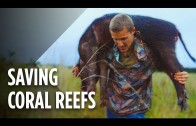How Algae Could Change The Fossil Fuel Industry: https://www.youtube.com/watch?v=yCNkmi7VE0I&list=UUJsSEDFFnMFvW9JWU6XUn0Q&index=5
Subscribe! https://www.youtube.com/c/seekerstories?sub_confirmation=1
Join the Seeker community!
Twitter: https://twitter.com/SeekerNetwork
Facebook: https://www.facebook.com/pages/Seeker-Network/872690716088418?ref=hl
Instagram: http://instagram.com/seekernetwork
Tumblr: http://seekernetwork.tumblr.com
App – iOS http://seekernetwork.com/ios
App – Android http://seekernetwork.com/android
The ocean is fundamental to all life on Earth. It covers 70% of our planet, dictates weather, regulates temperature, and takes carbon dioxide out of the atmosphere. On the ocean floor lies one of the most diverse marine ecosystems in the world: coral reefs.
“There’s no other ecosystem on this planet that occupies such a small geographic area, but has more forms of life than coral reef ecosystems. They’re unprecedented,” Dr. Jamie Gove, a research oceanographer at NOAA, told Seeker’s correspondent, Kyle Thiermann. “One in four of all marine organisms live in association with coral reefs, but they occupy less than one-tenth of 1% of the seafloor.”
Although known for their beautiful appearance, the reefs are vital to humans and marine life alike. Life without coral reefs would likely mean millions of species dying. It would also mean losing reefs as a new source for medical research, which in the past has led to new medications that treat cancer, arthritis, Alzheimer’s, and many other conditions.
As much as coral reefs provide for the planet, they are very delicate, and reefs around the world are currently dying off at an alarming rate. Coral bleaching occurs in high water temperatures and affects the coral’s zooxanthellae. Zooxanthellae are photosynthetic algae that live within the issue of coral polyp and give healthy coral a bright color, as well as nutrients. When the water becomes too hot, the coral expel the zooxanthellae. At this point, the coral are not dead, but they’re vulnerable.
There have been many incidents recently that have decimated coral, like in 1998 when El Nino triggered a bleaching event that killed 16% of coral reefs around the world. A similar event happened during La Nina of 2010, and again in October of 2015. This event is ongoing and has become the longest bleaching event in recorded history.
With time and reduced climate intensity, bleached reefs can come back to life, but it’s much harder when they are additionally stressed by land based activities.
“I think we have seen declines in reef ecosystems for decades now and so I think that we’re slowly reaching a tipping point which once we reach that point, reefs will be on a negative trajectory that there’s no turning back,” said Dr. Gove. “The only way that we can promote reef ecosystem resilience is by changing what we’re doing on land, that currently impacts reef ecosystem health.”
One of these factors are the feral pigs and goats in Hawaii. Chad Wiggins, Marine Program Director at The Nature Conservancy Hawaii, is working towards solutions to manage the hooved animals’ growing population numbers, and in effect, hopefully provide relief for coral to survive the effects of climate change.
Feral pigs and goats cause damage for coral as they dig up grounds in search for worms and snails in Hawaii’s forests, and that’s where the problem begins.“Once the rains come intermittently and flood these streams, that’s when they get a big bolster of sediment onto the reef,” explained Wiggins. “If it’s smothered, it can’t get sunlight, it can’t get oxygen, it can’t get nutrients and it’s dead. If the coral manages to survive, every time the waves come it gets re-suspended and the sediment continues to do damage, sometimes for decades.”
Native residents of Hawaii, like Pono Hiu, feel very protective of both coral and feral pigs. Approximately 500 million people depend on reefs for food to feed their families. Reefs also support livelihoods by contributing $30 billion to the global economy each year through fishing, recreation, and tourism.
“It would be a sad day to jump into this ocean and not see any coral for me. I take my son out here and I dive all the time and poke fish to feed my family. This ocean provides food for a lot of us here in Hawaii,” said Hiu.
Hiu and his family have lived in Hawaii for generations, and are also eager to find solutions where pigs and coral can coexist.
“Pigs play a major role in our life. Pretty much all my friends and family hunt or utilize these pigs from these mountains to feed their families either on a daily or weekly basis. Pigs have been here since man has been here.”
“What needs to happen is management,” said Wiggins. “If we want to have a healthy native forest, there have to be some areas that don’t have pigs in them and finding where those areas are is something where conservationists and hunters have to work together.”














